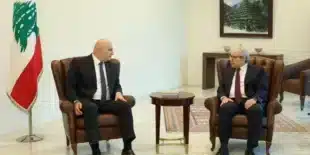The truce in Gaza witnessed one of its smoothest hostage-prisoner exchanges on Saturday, as Israeli captives were released in return for Palestinian detainees. Meanwhile, the crucial Rafah border crossing reopened ahead of anticipated discussions on the next, more challenging phase of the ceasefire agreement.
Israeli Prime Minister Benjamin Netanyahu is set to meet U.S. President Donald Trump at the White House on Tuesday, an opportunity for him to emphasize Israel’s stance and future plans following 15 months of war. The next phase of the ceasefire aims to negotiate the release of remaining hostages and extend the truce indefinitely. If no agreement is reached, hostilities could resume in early March.
Netanyahu’s office confirmed that he spoke with Trump’s Middle East envoy, Steve Witkoff, on Saturday evening. They agreed that negotiations on the second phase would commence at their meeting on Monday, with Witkoff also planning discussions later in the week with mediators from Qatar and Egypt.
As part of the latest exchange, Hamas released three male captives, while Israel freed 183 Palestinian prisoners. Another exchange is expected next Saturday.
The hostages—Argentinian-Israeli Yarden Bibas, French-Israeli Ofer Kalderon, and American-Israeli Keith Siegel—were handed over to Red Cross officials at different locations in Gaza. Their release follows the Hamas-led attack on Israel on October 7, 2023, which sparked the war. With these latest releases, 18 captives have now been freed since the ceasefire took effect on January 19.
Unlike previous releases, which saw chaotic scenes, Saturday’s exchange was more structured, with armed Hamas militants forming orderly lines as the captives were escorted onto a stage to wave to the crowd. The militant group has attempted to project control in Gaza despite the loss of key military leaders.
Shortly after the exchange, a bus carrying more than two dozen Palestinian prisoners departed from Ofer Military Prison for the Israeli-occupied West Bank. The prisoners were met with celebrations, as crowds lifted them onto their shoulders in triumph. Some of those released appeared frail and visibly affected by their time in detention.
According to Israel’s Prison Authority, all 183 Palestinian detainees set for release have now been freed. Among them, 111 had been detained after Hamas’ October 7 attack but were not directly involved in it. These individuals, held without trial, were sent to Gaza. Seven others, serving life sentences, were transferred to Egypt.
Emotional Reunions and Lingering Uncertainty
Siegel, a 65-year-old originally from Chapel Hill, North Carolina, had been taken hostage from Kibbutz Kfar Aza, along with his wife Aviva, who was freed during a previous ceasefire. Members of his kibbutz expressed relief and joy upon his release.
His niece, Tal Wax, noted, “He’s lost a lot of weight, but he’s walking, talking, and he’s still himself. One of the first things he said was that he’s still vegan.”
The release of 35-year-old Bibas brought renewed focus on the fate of his wife, Shiri, and their two sons, Ariel and Kfir, who were 4 years old and 9 months old at the time of their capture from Kibbutz Nir Oz. Kfir, the youngest of the approximately 250 people abducted, became a symbol of Israeli anger and helplessness.
Hamas has claimed that Shiri and her sons were killed in an Israeli airstrike, but Israel has yet to confirm this. Israeli officials have expressed grave concern over their fate.
Upon reuniting with his family, Bibas closed his eyes as his father, Eli, and sister, Ofri, embraced him in tears. His father whispered, “Sweetheart.” The Bibas family later released a statement saying, “A quarter of our heart has returned to us.”
Kalderon, 54, who was also taken from Kibbutz Nir Oz, was reunited with his children, Erez and Sahar, who had been released in a previous ceasefire. “I am here. I didn’t give up,” Kalderon told them as they embraced.
The Palestinian detainees released also shared emotional moments with their families. Some expressed mixed feelings of sadness and joy, knowing that many of their fellow detainees remain behind bars.
Mohammad Kaskus, who had been serving a 25-year sentence for attacks against Israelis, remarked, “It’s an indescribable feeling, but we cannot forget our brothers still imprisoned.”
For Yaser Abu Hamad, arrested in 2006 for his involvement with the Islamic Jihad militant group, the return home was bittersweet. He discovered that 20 of his family members, including his mother and sisters, had been killed in Israeli airstrikes. His first act after release was visiting their graves.
Several former detainees described experiencing harsh conditions in Israeli prisons, including physical abuse. The Israeli Prison Authority has not responded to these allegations.
A Temporary Respite for Gaza
The ceasefire, now two weeks old, has facilitated the entry of hundreds of aid trucks into Gaza and allowed many Palestinians to return to their devastated homes in the northern part of the enclave.
In a further sign of de-escalation, 50 sick and wounded Palestinian children were granted permission to leave Gaza for medical treatment through the Rafah border crossing into Egypt. This marked the first time the crossing had been opened since Israel took control of it nine months ago.
During the initial six-week phase of the ceasefire, 33 Israeli captives are set to be exchanged for nearly 2,000 Palestinian prisoners. Israel has confirmed that Hamas provided information indicating that eight of those hostages are dead. About 80 captives remain in Gaza.
Naama Weinberg, cousin of deceased captive Itay Svirsky, addressed both sides of the conflict at a weekly gathering in Tel Aviv, saying, “We will not allow you to blow up this deal. We will not allow you to force us back into war or to sentence the captives left behind to death.”
The Road Ahead: More Talks, Uncertain Outcomes
Despite the temporary ceasefire, Israel remains committed to dismantling Hamas, while the militant group insists it will not release the remaining hostages without an end to the war and a complete Israeli withdrawal from Gaza.
The initial October 7 attack, which ignited the war, reportedly resulted in around 1,200 deaths in southern Israel. Since then, Israel’s air and ground offensive has killed more than 47,000 Palestinians, including a significant number of women and children, according to Gaza’s Health Ministry.
The Israeli military claims it has killed over 17,000 militants, though it has not provided evidence for this figure. Israel continues to blame Hamas for civilian casualties, arguing that the group operates from within residential areas.
As negotiations for the next phase of the ceasefire loom, both sides remain deeply entrenched in their positions. If a new agreement is not reached, hostilities could resume by early March.


